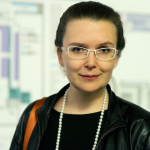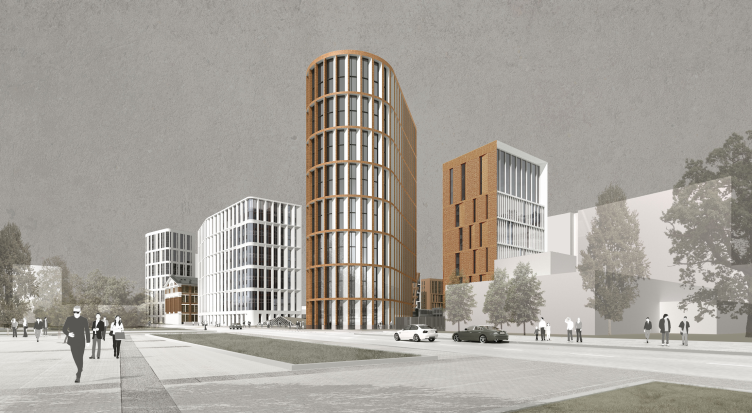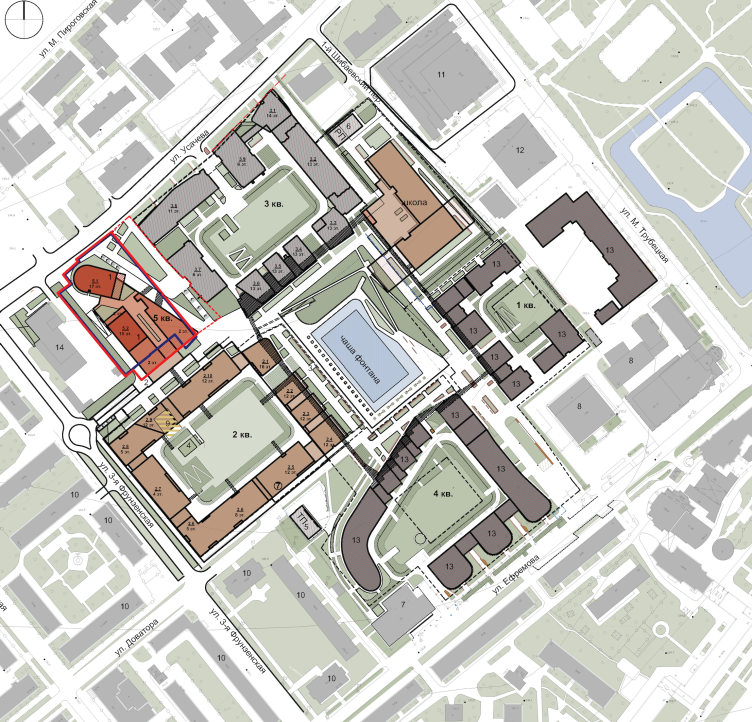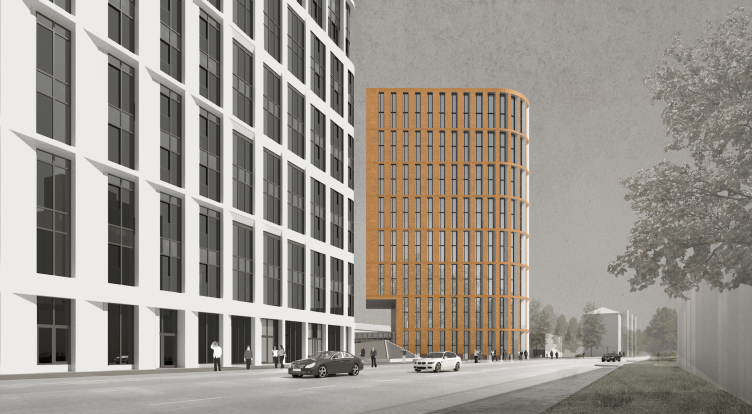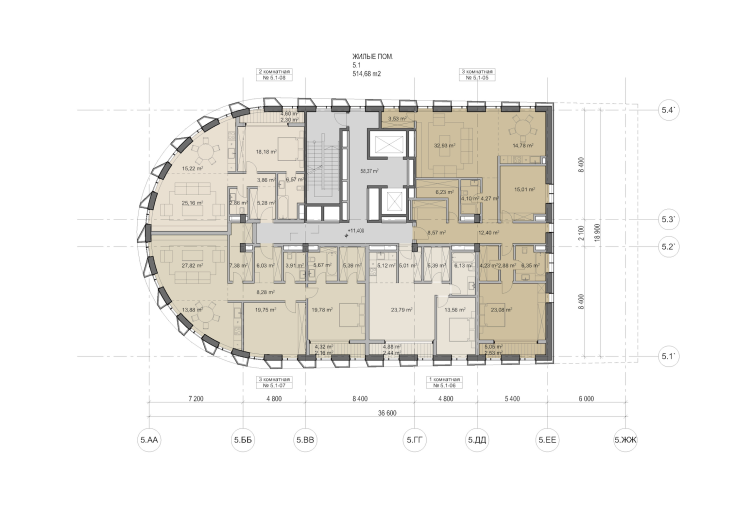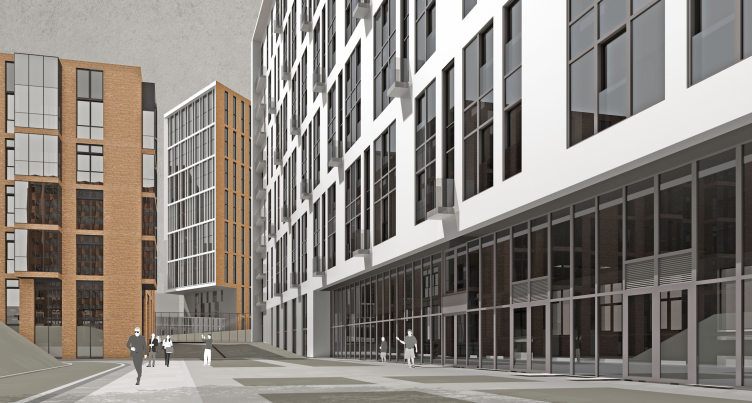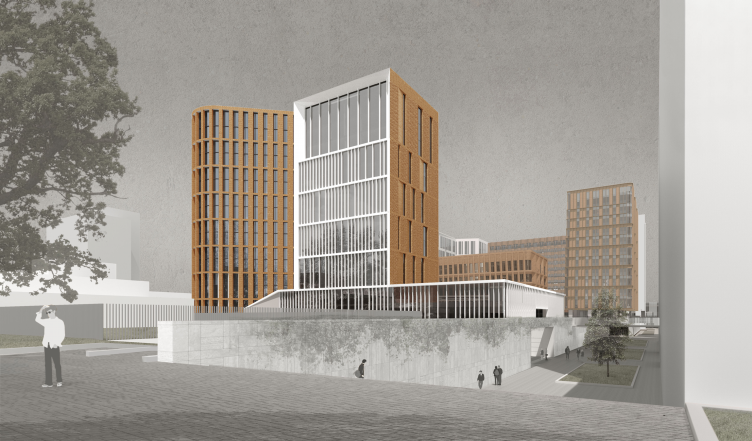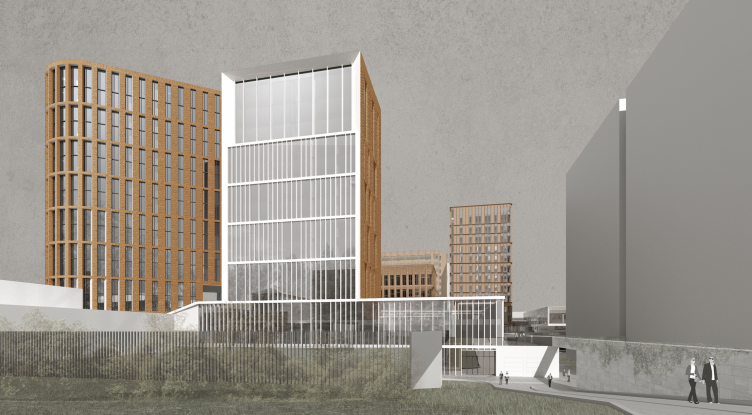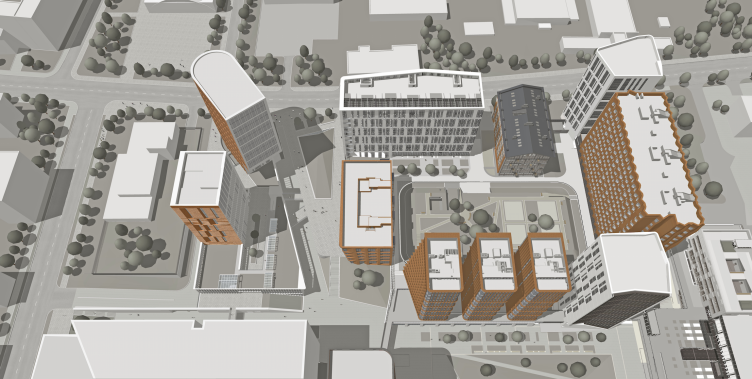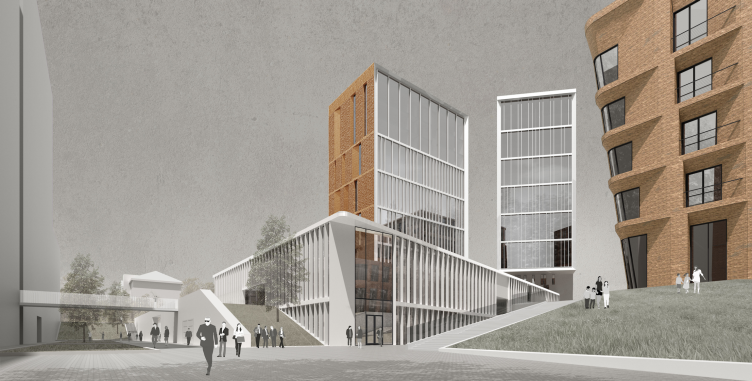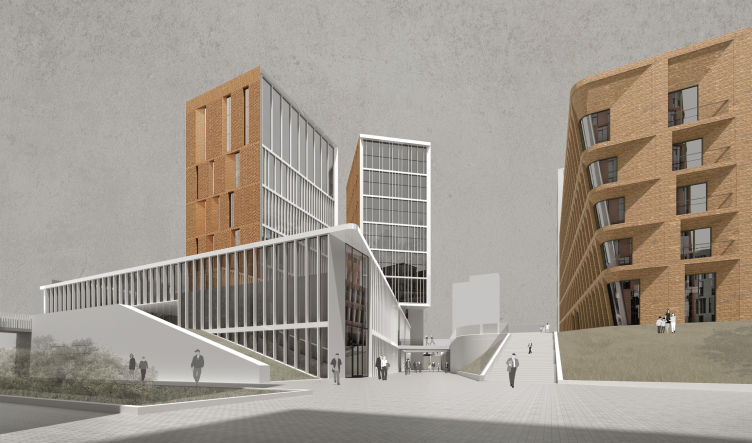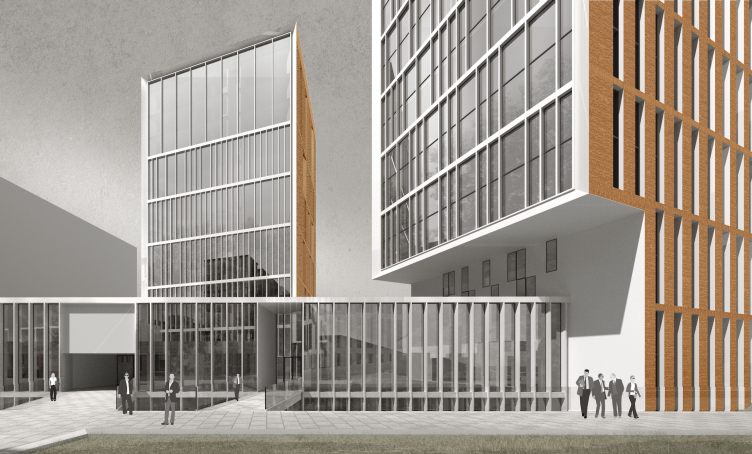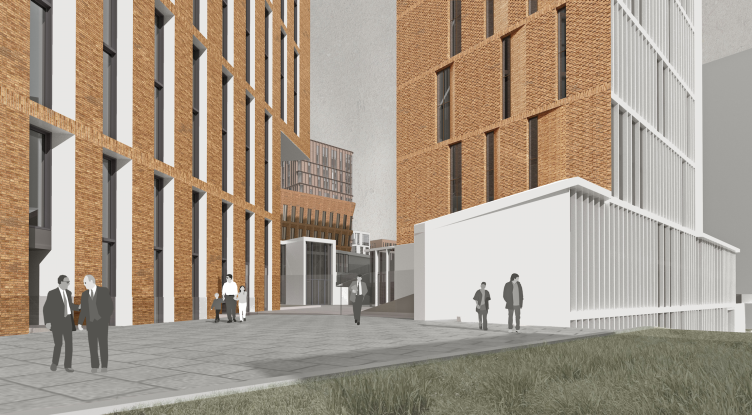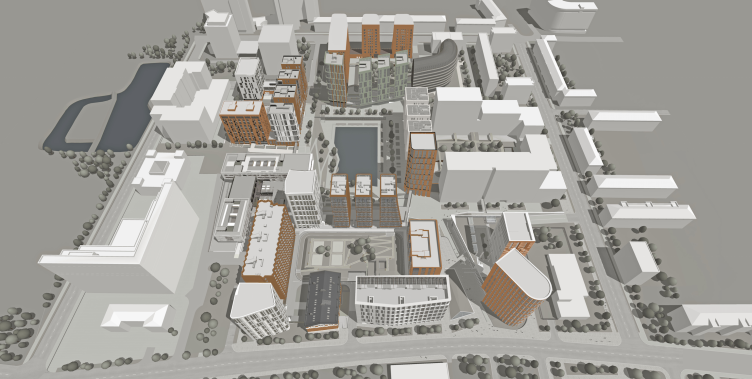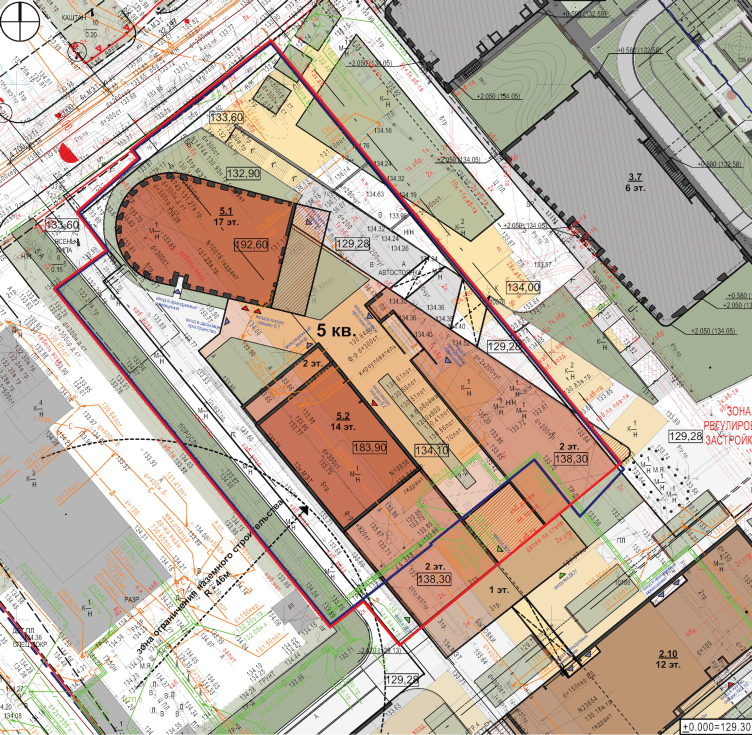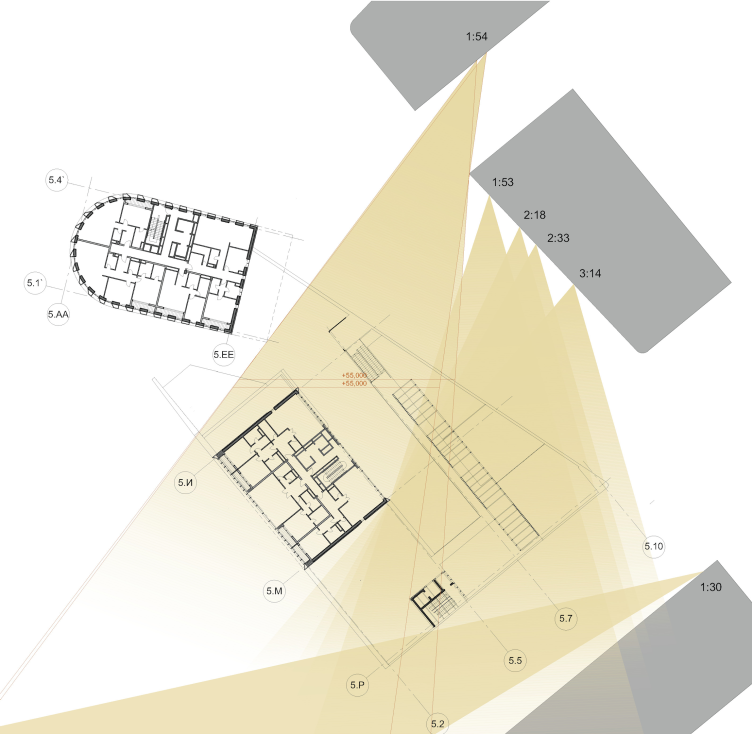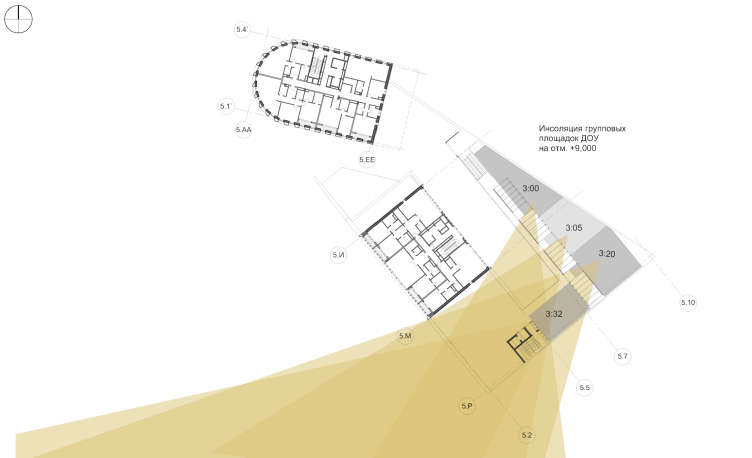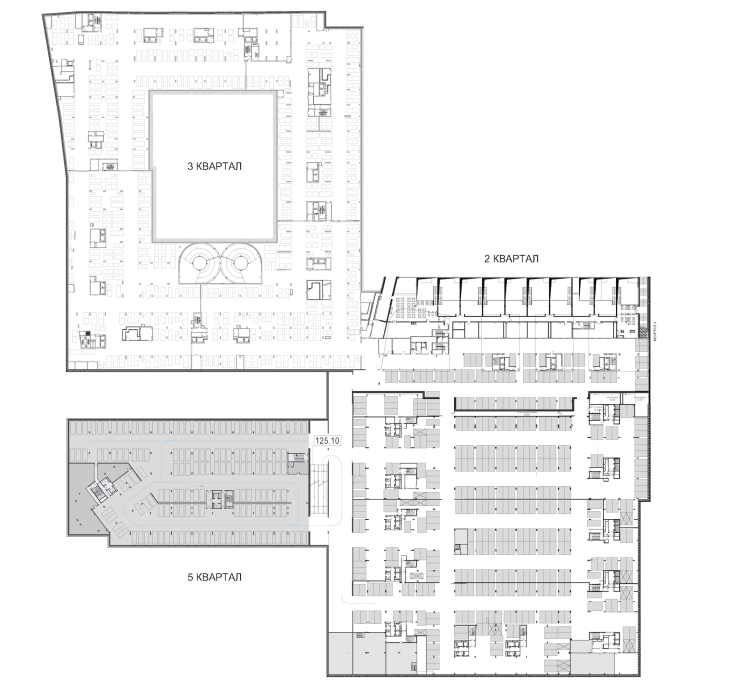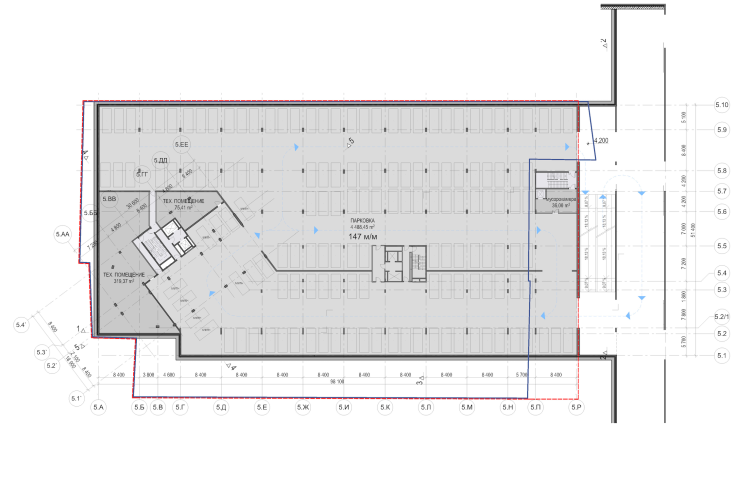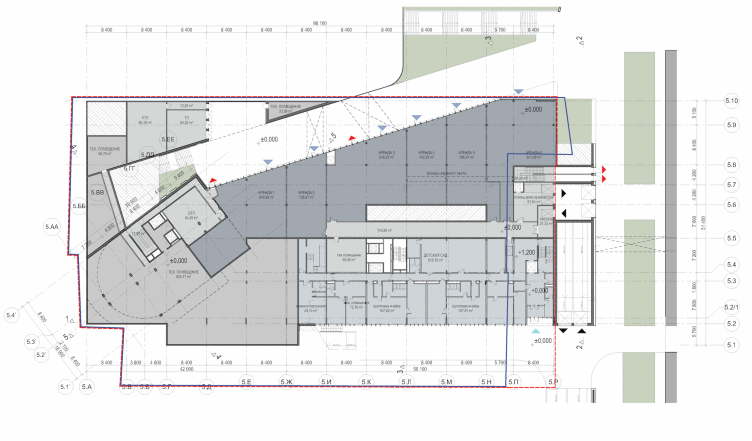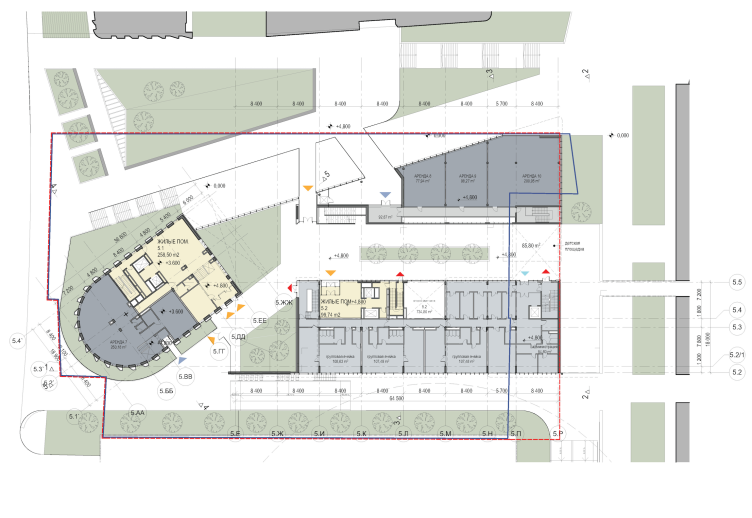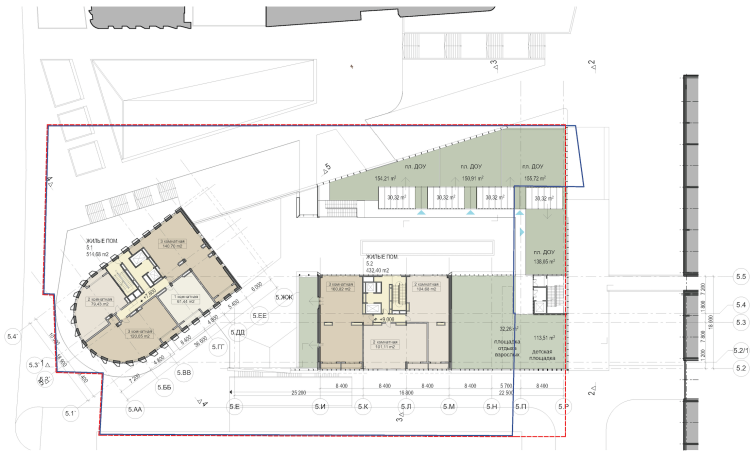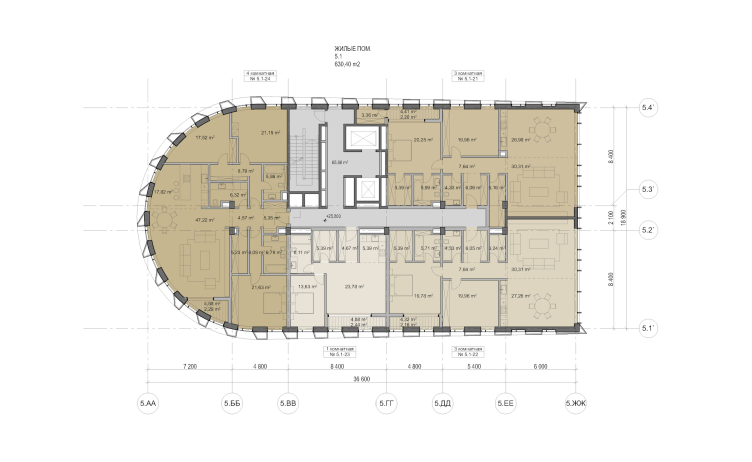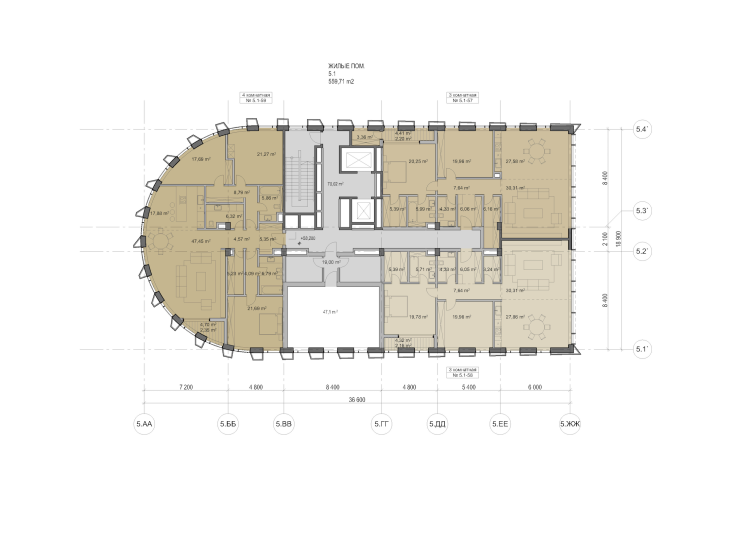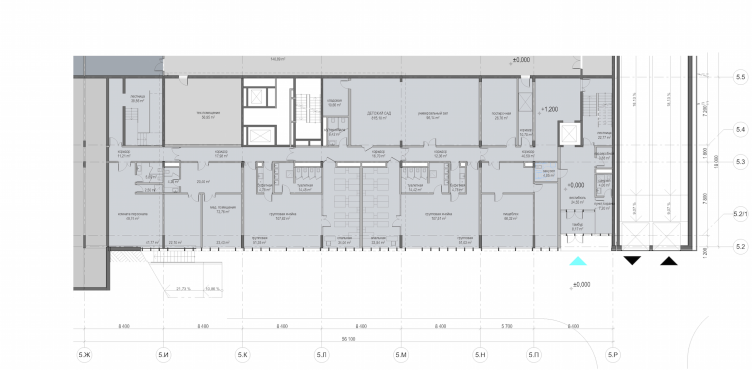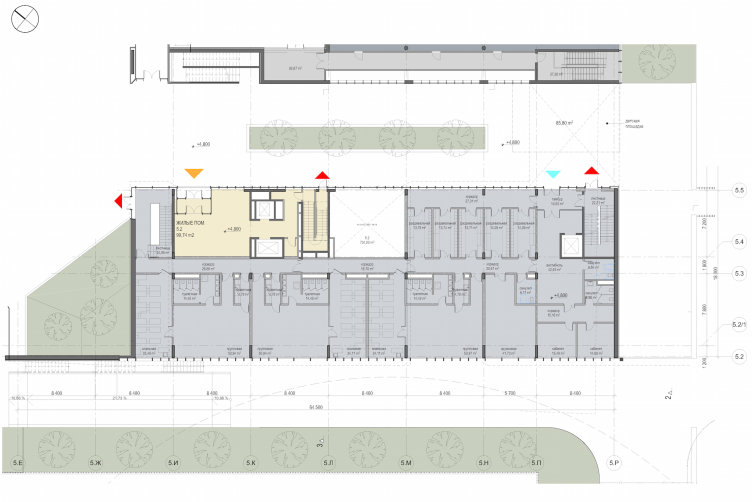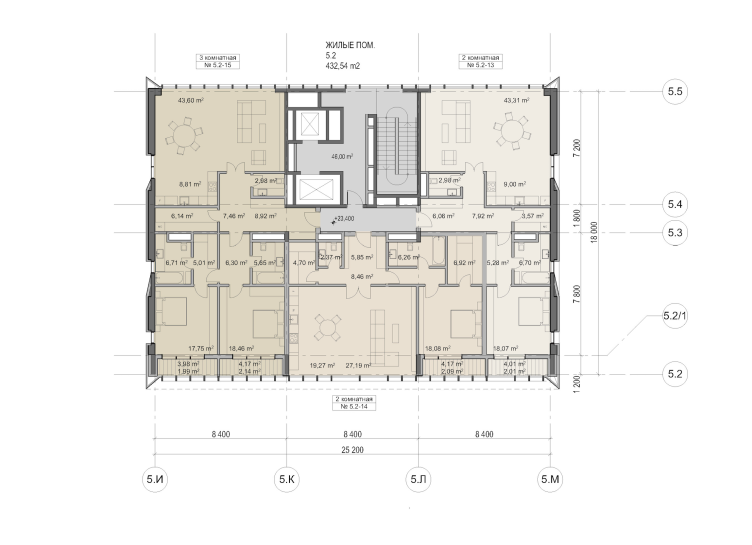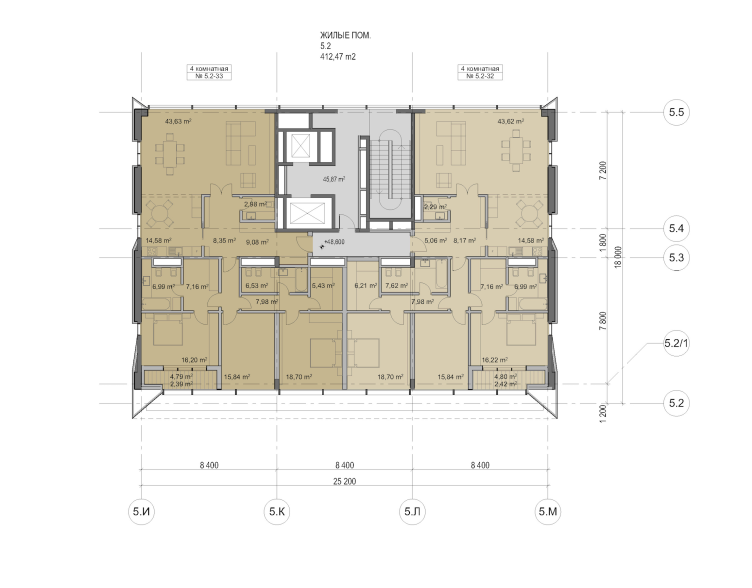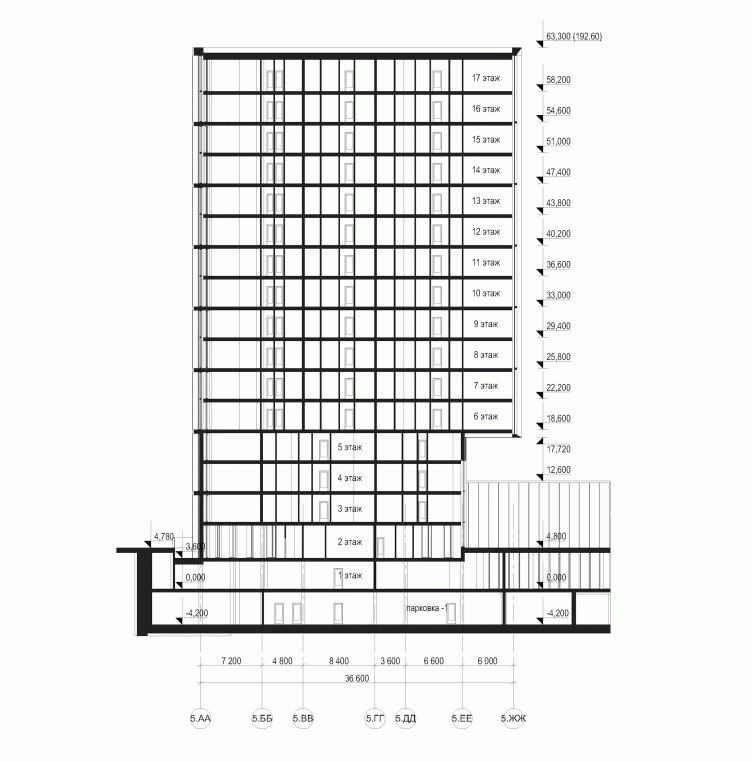The project of "Quarter 5", part of "Garden Quarters" complex, was developed by Sergey Skuratov in 2015. Two residential buildings are to occupy the western corner of the territory between Quarter 2 and Quarter 3; initially, this land site was twice as large, and there were plans of handing it over to office buildings, but later on, in 2008, it was decided to switch its function to a residential one, also foregoing the idea of demolishing a small fire station building stretching along the site's outside contour. The construction blueprint shrank to about half of its original size and took on an elongated shape. Today it is the smallest quarter of the complex, about a fourth or a third of the size of the others.
This place, however, is vitally important from the town-planning standpoint. In fact, this is the "grand entrance" to "Sadovye Kvartaly" - because it is this particular corner that faces both to the walkway leading to the "Sportivnaya" metro station, and the city square in front of the "Usachevsky" marketplace. Today, the square is basically cluttered with cars but still, in terms of typology, it is in fact a market square and a center of the area's social life; the market, covered by the concrete wing of the sail-like vault, is not so simple from the architectural standpoint, either. In his project, Sergey Skuratov, the author of the concept, the design code, and more than a half of all the buildings of "Garden Quarters", distinguished, above all else, the town-planning importance of the land site and its role of the grand entrance to the new complex.
In addition, while still in the concept stage, the project had in it two diagonal axes that would offset each other and liven up the whole composition, one in the fourth quarter, aimed southeast, the other in the fifth, aimed southwest. The former was handled by Andrew Savin and "A-B" Bureau, and this place got a building that violated some of the design code (specifically, the part of brick being prevalent), looking forward to like the head of some mercury worm, but really interesting and striking - which only enhanced the "east-west" dichotomy that was there from the start in Sergey Skuratov project that he mentioned in passing still on the level of design code. Now the east is represented by the mercury "head" - the sculptural volume designed by Andrew Savin, horizontal, dense, and flowing downwards. As for Sergey Skuratov, he replied to this plastic challenge with a tower that is located exactly in the western corner of the territory and filled with Western Europe associations.
Multifunctional residential development in Khamovniki (Quarter 5 of "Sadovye Kvartaly" complex) © Sergey Skuratov Architects
Copyright: © Sergey Skuratov ARCHITECTS
Multifunctional residential development in Khamovniki (Quarter 5 of "Sadovye Kvartaly" complex). Location plan © Sergey Skuratov Architects
Multifunctional residential development in Khamovniki (Quarter 5 of "Sadovye Kvartaly" complex) © Sergey Skuratov Architects
Multifunctional residential development in Khamovniki (Quarter 5 of "Sadovye Kvartaly" complex) © Sergey Skuratov Architects
Multifunctional residential development in Khamovniki (Quarter 5 of "Sadovye Kvartaly" complex) © Sergey Skuratov Architects
The tower, especially if one is to look from the square of the Usachevsky market, wants to be described as a medieval torro, a residential tower of an influential family that established itself on the brink of some market "campo" in some "città", medieval but already Italian city that has begun to stand for its rights as a newly-born city. Such towers were very common between the XI and XIV centuries all over the territory of the former Roman Empire from Spain to Florence to the Middle East. It was such towers that served as the prototype of Florence's future palazzos. As well as bridgeheads and dungeons, mostly round-shaped and performing the function of protected residences. As well as belfries - one of them, the most famous tower of Pisa, Sergey Skuratov specially mentions when he shares about the project because the openwork quality of his façades can indeed put one in the mind of its colonnades. As an offset to the flowing "head" designed by Andrew Savin, Skuratov's tower like a rock of rational verticals standing out bristling with counterforce, with its rugged bricks on the outside, and sunny-white, as the light of Telperion, on the inside. Without a doubt, when implemented, this sharpened metaphor would tie in together a lot of nuances and enhance their meanings. "Garden Quarters" would have had two heads, one gazing westward and the other gazing eastward, which would have been a really symbolic thing in itself.
The outlines of the "western tower" are reservedly graphic, balanced, and at the same time not devoid of a few secrets that make examining it a pretty exciting thing to do: in motion, the façades would constantly be changing.
First of all, this is not at all a circular tower but a short parallelepiped with a distinctly "circularly" rounded side wall. It looks like a cylinder only from the front-view position. The opposite side wall looking at the center of the complex is sliced away but is at the same time accentuated by a dramatic cantilever: its five lower floors are have an inside cutaway several meters deep. Because this part of the volume falls into shade and there is no point making apartments here -the architect explains.
Multifunctional residential development in Khamovniki (Quarter 5 of "Sadovye Kvartaly" complex) © Sergey Skuratov Architects
Multifunctional residential development in Khamovniki (Quarter 5 of "Sadovye Kvartaly" complex) © Sergey Skuratov Architects
The façades of the rounded section and the walls adjoining it are rather made of bricks. We say "rather" because originally it was planned that the brick (top-quality Flemish Brick "Gent" from Hagemaster, with a slight tone gradient and moderate ruggedness) would only be used for coating the outside surfaces. All the depths and spacious window jambs were supposed to be dazzling white, even slightly glittering in the dark - made from Stoneglass alloy with a self-explanatory name. It looks as though the window jambs, very much like a sliced apple, display the foam-white matter of the walls - suggesting that the building is white "on the inside". Which, of course, is not quite the case: all the concrete pillars are of the same thickness but there are also hollow boxes set next to them that form the architectural relief: the pillars of the rounded "tower" part are more prominent and look faceted because of the slants, while, as they go over to the side walls, they lose their thickness and become wider. When viewed from the south, the tower will look as if it is made of brick, and if one goes north down the Usachevskaya Street, the tone of the façade will be smoothly changing in a gradient way - from terra-cotta to white and back to terra-cotta again, like a page of half-opened book. In addition, this agile gradient serves as a transition - a color "bridge" - between the brick building in the south and the light-colored façades of Quarter 3 in the north. And if we take a look at their plan, they look a bit like a tractor track or maybe a circular saw - because the slants are asymmetric and are only there on the north side. One should hardly mention the fact that the prominent pier buttresses go a long way to enhance the "fortress" associations without so much as a hint at literalism. The historical associations are also strengthened by the fact that the perimeter walk is sunken in a little bit, which refers the observer to the memories about the unearthed Novgorod temples standing in the basin of the cultural layer excavated by the archaeologists - the same technique was used by Sergey Skuratov in order to enhance the contextual flavor in the building of Art House in the Tessinsky Alley.
Multifunctional residential development in Khamovniki (Quarter 5 of "Sadovye Kvartaly" complex). Plan of floors 3-5 of Building 5.1 © Sergey Skuratov Architects
Besides the conceptual meaning, the pier buttresses also serve a practical purpose: from the inside, they uncover as much as possible the views of the Novodevichy Monastery and the Sparrow Hills, getting as much sunlight as they possibly can - which, as a matter of fact, conditioned the thought-out angles of the building's surfaces. The subtleties do not stop at the pattern of the depths and angles, though: the windows also grow consecutively wider from bottom to top, while the piers grow narrower, visually unburdening the volume and playing with the perspective.
The opposite "cantilever" side picks up and develops the idea: with one of its sections cut off vertically, it stands completely made of glass encased in a thin white "television" frame. Which also works to support the observer's initial conviction that on the inside the building's walls are white, at the same time demonstrating the hollowness of the shell, adding a histrionic twist to the whole picture, some scenic essence of the metaphor used in the dialogue with the observer. Besides, the stained glass leaves no doubt as to the immanent "up-to-date" quality of Sergey Skuratov's architecture, which is important to the author, in spite of all his "literary" love of dialogue with the context.
Multifunctional residential development in Khamovniki (Quarter 5 of "Sadovye Kvartaly" complex) © Sergey Skuratov Architects
The first centerpiece tower has been designed taller than it was provided for in the design code of "Garden Quarters" - seventeen floors high. As for the other tower, it obeys the rules, being the mere twelve stories high. It stretches along the boulevard that continues from the "Sportivnaya" metro station and separates Quarter 5 and Quarter 2. The architecture of the second tower echoes its neighbor but it is a little more reserved. The side wall surfaces, though, are coated with an array of prominent bricks arranged in a staggered order which makes the play of light and shade particularly interesting. The window jambs are smooth and made of bricks; it was even planned that their brickwork would use a certain amount of occasional glittering (like lurex threads) inserts. The embossed surface is open to the environment also from the conceptual standpoint because the wall looks as if it is porous and water-absorbing; conceptually, it all looks so much like brick joggle that the eye gets an impression that either something was torn away from the wall or it waits for an annex to be built. Thus, the side walls of this tower "stretch" apart trying to fit in with the overall rhythm of the surrounding buildings; the window jambs, on the other hand, establish themselves as decorated cavities. The elongated walls of the second tower are glass "televisions", and when viewed from the vantage point of the "Sportivnaya" metro station, it looks like some gigantic portal into another dimension. If we let our imagination wander a little bit further, we might see in Sergey Skuratov's Quarter 5 the outline of a city gate and a tower standing next to them - which makes perfect sense for this place because it is in fact the entrance to the complex.
Multifunctional residential development in Khamovniki (Quarter 5 of "Sadovye Kvartaly" complex) © Sergey Skuratov Architects
Multifunctional residential development in Khamovniki (Quarter 5 of "Sadovye Kvartaly" complex) © Sergey Skuratov Architects
Multifunctional residential development in Khamovniki (Quarter 5 of "Sadovye Kvartaly" complex) © Sergey Skuratov Architects
Both buildings are set on a stylobate whose height grows up to two floors as relief of "Garden Quarters" goes down closer to the central part of the territory where, as is known, a pond is situated. Turned, for the better part, on the inside part of the complex, the façades of the stylobate are pretty much of the same kind as the façades of the stained-glass parts of the towers: glass, slightly faceted, and sporting vertical white lamellae. It was also planned that on its south side and along the boulevard down which commuters would walk home from the metro station, the stylobate would get a kindergarten with a playground on its roof; this same place got the parking garage entrance ramp, separated from the kindergarten by a hedgerow. Along the north facade, shops, cafes, and other "public functions" would be situated that would turn the deep funnel of the second boulevard (triangular on the plan) into a city square - a cultured pendant of the market square across from it that will also possibly find its own urban designer one day.
Multifunctional residential development in Khamovniki (Quarter 5 of "Sadovye Kvartaly" complex) © Sergey Skuratov Architects
The triangular square, according to Sergey Skuratov's apt expression, was meant to "suck" (like the Bermuda Triangle) people into the whirlpool of the narrowing public space. The intrigue is made still more complex because of the fact that two tiers are involved here: as we have already said, the transformed terrain of the entire residential complex lowers significantly towards the center of its territory. On the land site of Quarter 5, the elevation gain is felt very strongly, and for this reason the stylobate is equipped with ramps and footbridges connecting it to Quarters 2 and 3 which is convenient for at least taking your kids to school. Generally speaking, hanging footbridges is the signature feature of "Garden Quarters" - they are to be seen all around the place here. The triangular square and its narrowed end get by their sides a few staircases leading to the lower tier of the stylobate. The entrances to the stores are organized both on the first and on the second floors - the territory of the triangular boulevard turns out to be a compound invention, its parts interpreting the height difference in their own unique ways.
Multifunctional residential development in Khamovniki (Quarter 5 of "Sadovye Kvartaly" complex) © Sergey Skuratov Architects
Copyright: © Sergey Skuratov ARCHITECTS
Multifunctional residential development in Khamovniki (Quarter 5 of "Sadovye Kvartaly" complex) © Sergey Skuratov Architects
Multifunctional residential development in Khamovniki (Quarter 5 of "Sadovye Kvartaly" complex) © Sergey Skuratov Architects
Multifunctional residential development in Khamovniki (Quarter 5 of "Sadovye Kvartaly" complex) © Sergey Skuratov Architects
Multifunctional residential development in Khamovniki (Quarter 5 of "Sadovye Kvartaly" complex) © Sergey Skuratov Architects
Multifunctional residential development in Khamovniki (Quarter 5 of "Sadovye Kvartaly" complex) © Sergey Skuratov Architects
As we can see, the project works on a whole number of levels - from the exciting multilevel organization of pedestrian territories and various public functions in the lower floors to the detailed façades, plastic accents, and the meaningful "literature" part of the overall concept. In many respects, Sergey Skuratov made Quarter 5 pretty much the key entrance to the residential complex that has for eight years already had the fame of Moscow's model of new approach to town planning and building elite residential stock. Meanwhile, in the process of working on the concept, nearly at the point of completion, it suddenly became known that this project was participating in a tender with but one other company as its contender. Still further on down the line, the customer ("Inteko" Company) chose that other project over Sergey Skuratov's. So, all things considered, this project is unlikely to be implemented, which, of course, is a sad thing to realize because otherwise it could have become not only the logic consummation of the author's concept but also a successful town-planning accent making a positive difference for Moscow's Khamovniki District.
Multifunctional residential development in Khamovniki (Quarter 5 of "Sadovye Kvartaly" complex). Transportantion layout © Sergey Skuratov Architects
Multifunctional residential development in Khamovniki (Quarter 5 of "Sadovye Kvartaly" complex). Master plan © Sergey Skuratov Architects
Multifunctional residential development in Khamovniki (Quarter 5 of "Sadovye Kvartaly" complex). Insolation © Sergey Skuratov Architects
Multifunctional residential development in Khamovniki (Quarter 5 of "Sadovye Kvartaly" complex). Insolation of the apartments © Sergey Skuratov Architects
Multifunctional residential development in Khamovniki (Quarter 5 of "Sadovye Kvartaly" complex). Insolation © Sergey Skuratov Architects
Multifunctional residential development in Khamovniki (Quarter 5 of "Sadovye Kvartaly" complex). Insolation of kindergarten venues © Sergey Skuratov Architects
Multifunctional residential development in Khamovniki (Quarter 5 of "Sadovye Kvartaly" complex). Underground parking garage. Layout © Sergey Skuratov Architects
Multifunctional residential development in Khamovniki (Quarter 5 of "Sadovye Kvartaly" complex). Underground parking garage. Plan © Sergey Skuratov Architects
Multifunctional residential development in Khamovniki (Quarter 5 of "Sadovye Kvartaly" complex). The first level of the stylobate © Sergey Skuratov Architects
Multifunctional residential development in Khamovniki (Quarter 5 of "Sadovye Kvartaly" complex). Plan of the level of the entrance areas © Sergey Skuratov Architects
Multifunctional residential development in Khamovniki (Quarter 5 of "Sadovye Kvartaly" complex). Plan of the third floor of Building 5.1 © Sergey Skuratov Architects
Multifunctional residential development in Khamovniki (Quarter 5 of "Sadovye Kvartaly" complex). Plan of floors 7-16 of Building 5.1 © Sergey Skuratov Architects
Multifunctional residential development in Khamovniki (Quarter 5 of "Sadovye Kvartaly" complex). Plan of the 17th floor of Building 5.1 © Sergey Skuratov Architects
Multifunctional residential development in Khamovniki (Quarter 5 of "Sadovye Kvartaly" complex). Plan of the first level of Building 5.2 © Sergey Skuratov Architects
Multifunctional residential development in Khamovniki (Quarter 5 of "Sadovye Kvartaly" complex). Plan of the second level of Building 5.2 © Sergey Skuratov Architects
Multifunctional residential development in Khamovniki (Quarter 5 of "Sadovye Kvartaly" complex). Plan of the third floor of Building 5.2 © Sergey Skuratov Architects
Multifunctional residential development in Khamovniki (Quarter 5 of "Sadovye Kvartaly" complex). Plan of the 6th floor of Building 5.2 © Sergey Skuratov Architects
Multifunctional residential development in Khamovniki (Quarter 5 of "Sadovye Kvartaly" complex). Plan of floors 12-14 of Building 5.2 © Sergey Skuratov Architects
Multifunctional residential development in Khamovniki (Quarter 5 of "Sadovye Kvartaly" complex). Section view © Sergey Skuratov Architects
Multifunctional residential development in Khamovniki (Quarter 5 of "Sadovye Kvartaly" complex). Section view © Sergey Skuratov Architects
